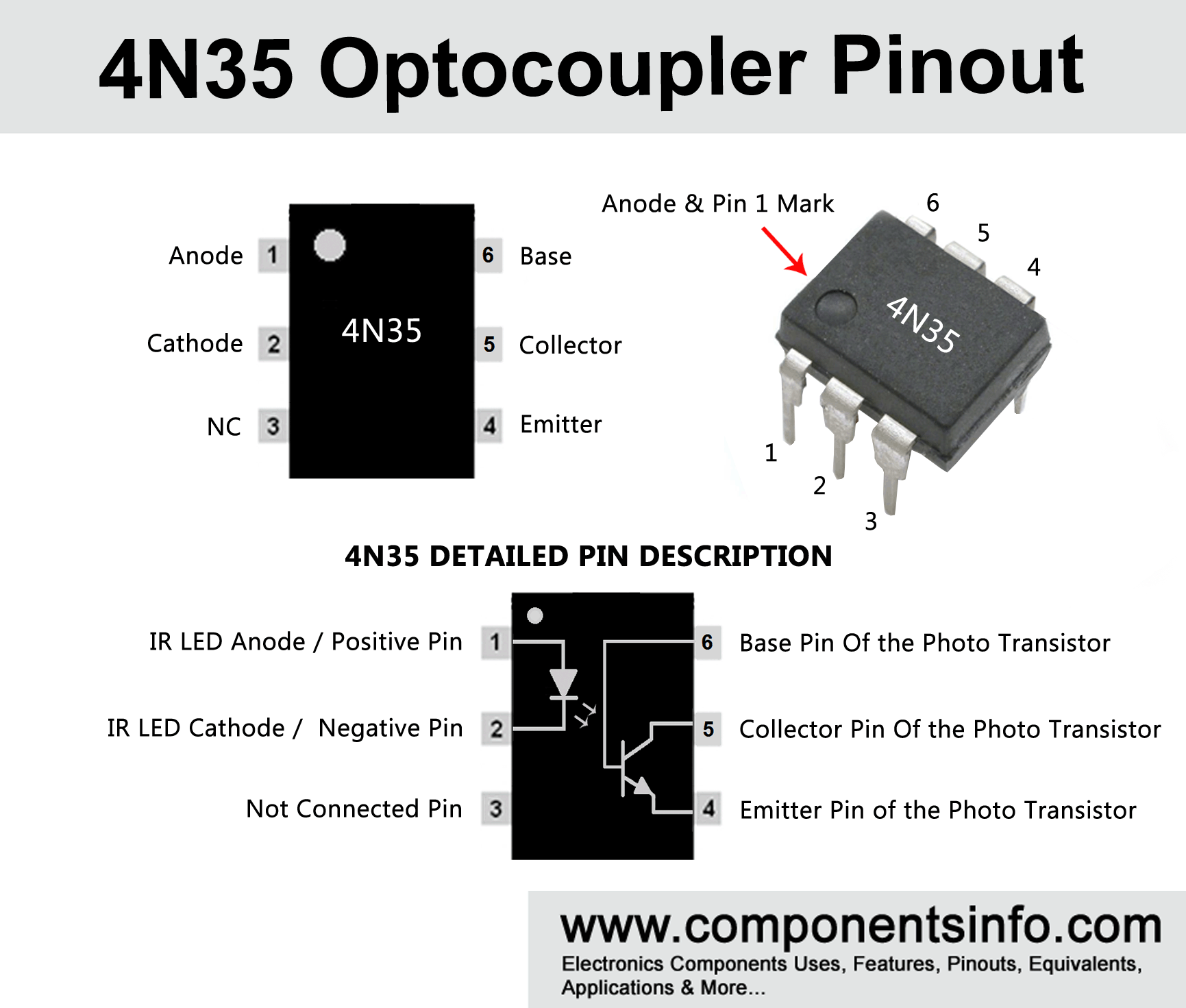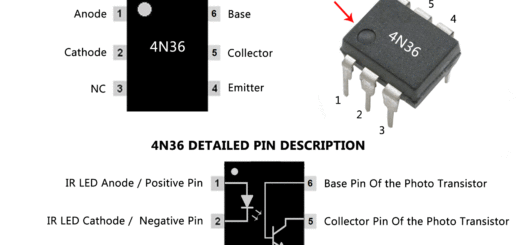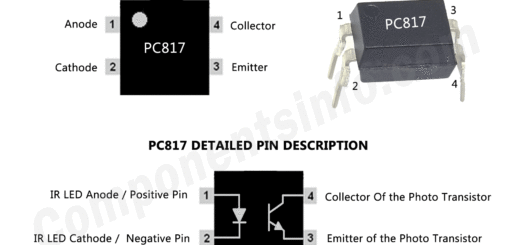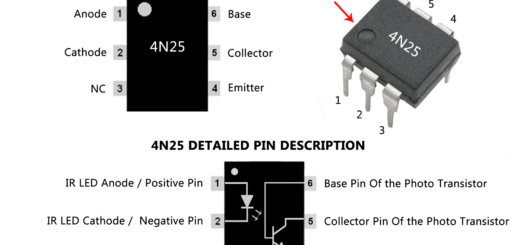4N35 Optocoupler Pinout, Datasheet, Equivalent & Other information
4N35 is a widely used optocoupler device. The post below covers 4N35 optocoupler pinout, datasheet, equivalent & other information about this device.
4N35 Features / Technical Specifications:
- Package Type: 6 Pin Dip & SMD
- Transistor Type: NPN Photo Transistor
- Photo Transistor Max Collector Current(IC): 150mA
- Photo Transistor Max Collector-Emitter Voltage (VCEO): 30V
- Photo Transistor Collector-Emitter Saturation Voltage : 0.14 to 0.3
- Photo Transistor Max Emitter-Collector Voltage (VECO): 7V
- Photo Transistor Max Collector Dissipation (Pc): 150 Milliwatt
- LED Max Reverse Voltage (VR): 6V
- LED Max Forward Current: 60 Milliampere
- LED Max Power Dissipation: 120 Milliwatt
- Max Operating & Storage Temperature Should Be: -55 to +100 Centigrade for Operating & -55 to +150 for Storage.
4N35 Optocoupler Explained / Description:
4N35 is general purpose and widely used optocoupler or we can say it optoisolator & photocoupler & it is available in 6 pin dip and SMD packages. The device contains two parts one is an IR LED and the other part is the phototransistor. The working of the device is simple when power is applied to the IR LED which activates the LED, the IR light is detected by the phototransistor and as a result the transistor become saturated or switched ON. There are two base of the internal phototransistor from which it can be controlled one is the photo detection or IR light detection and other is connected with the pin6 of the device, therefore it can be controlled by two procedures at the same time.
The max collector-emitter voltage of the phototransistor is 30V and max collector-emitter current is 150mA. However the collector-emitter saturation voltage is from 0.14 to 0.3. Normally the saturation voltage of transistor is 0.6 or 0.7 volts but 0.3 volts is an ideal saturation voltage for applications where low voltage saturation is required.
As regarding the IR LED characteristics the max forward current is 60 milliampere and max power dissipation is 120 milliwatt. Pin3 is labeled with “NC” which means the pin3 have not connection with the internal circuitry.
Applications:
Isolation in circuits
Microcontrollers output to control devices
Power supplies and chargers
Digital application circuits
Telecommunication Applications / Circuits
AC Isolation Circuits
AC Detector Circuits
Replacement and Equivalent Part Numbers:
4N35 replacement and equivalent optocouplers are 4N36, 4N37, 4N25, 4N26, 4N28, PC816, PC817 , 4N27, 4N36 & H11Ax series.
Where TO Use 4N35 Optocoupler
4N35 optocoupler can be used for variety of general purpose requirements in electronic circuits. For example you can use it in electronic circuits to save the circuits, ICs and other components from voltage surge or voltage spikes which damages the components. Other than this it can also be used for isolation in electronic circuits. You can also use to detect voltage in AC and DC circuits, at the output of microcontroller Chips, controlling high power transistors, high voltage devices etc.
How TO Use 4N35 Optocoupler
Using 4N35 optocoupler is very easy, as discussed above the device contains two parts or components an IRLED and a Phototransistor, the LED Anode pin can be connected with the output of the device you are operating or working on (for example any IC or Microcontroller) and the cathode pin of the LED should be connected with the ground of that device, this LED should be handled same as you handle any other LED for example you have to use a current limiting resistor too. When the output of the device goes high the LED will become switched ON and the IR light with be detected by the photo transistor making it saturated or switched ON hence the collector and emitter pins will become shorted and as a result any wire connected with the pin 4 and 5 will be connected with each other. The internal phototransistor can also be controlled like a normal BJT transistor, the pin6 is connected with the base of the transistor and you can also use pin6 to control the transistor.
How to Safely Long Run in a Circuit:
For long term stability and performance of this device it is recommended that the user should not operate the device above its max ratings. Do not apply or operate load of 150mA through this device. Using a current limiting resistor with IR LED is always recommended. Do not operate the device in temperature above -55 centigrade and below +100 centigrade and always store above -55 centigrade and below +150 centigrade.
4N35 Datasheet :
To Download the datasheet just copy and paste the below link in your browser.
https://pdf1.alldatasheet.com/datasheet-pdf/view/50076/FAIRCHILD/4N35.html



